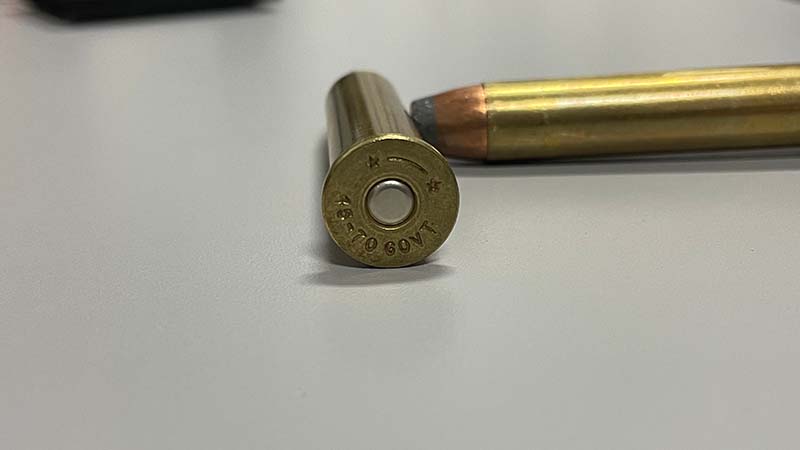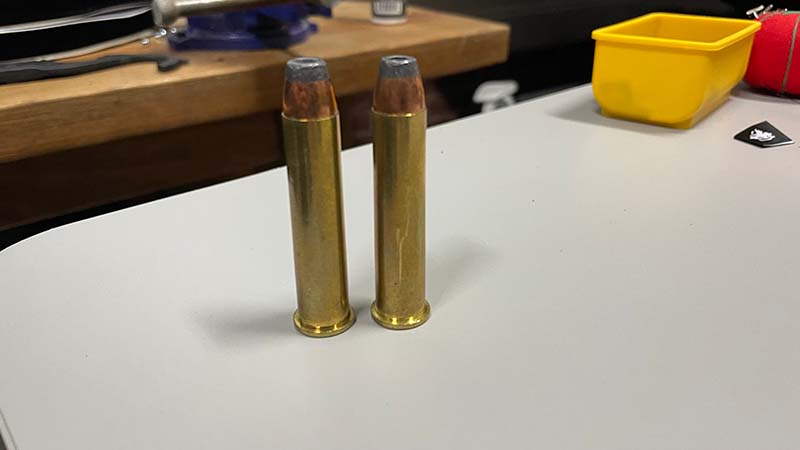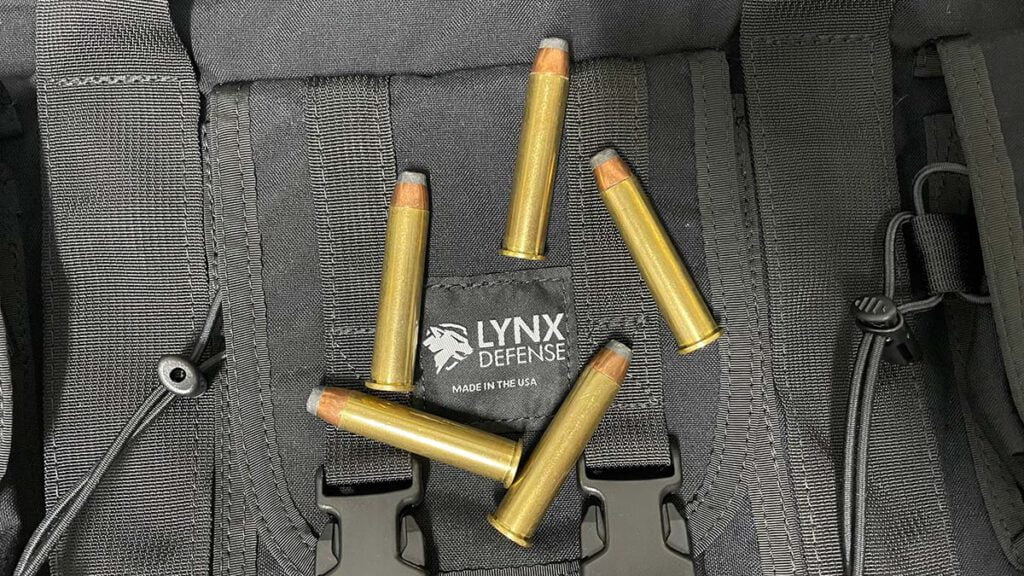
We may earn revenue from product links on this page and participate in affiliate programs. Learn More ›


We may earn revenue from product links on this page and participate in affiliate programs. Learn More ›
The .45-70 Government round, most commonly referred to as just 45-70, was created in 1873 by the United States Government.
This round is pretty unique because most ammunition was created to meet a demand for a specific firearm or a specific specification set by military customers.
The .45-70 round was actually created by the United States Governments Springfield Armory, this is not to be confused with Springfield Armory, Inc. which just copied the name to capitalize on the name recognition of the United States Armory at Springfield.
The original Springfield “Trapdoor” rifle was the gun this cartridge was developed for.
The .45-70 Government round is a rimmed straight rifle cartridge that was one of the first centerfire rifle cartridges ever invented it originally used black powder but since smokeless powder was developed it has since used that. The .45-70 Government round is also known as simply, .45 Government.

In modern times .45-70 is mostly known to be lever active rifle round, much like the .35 Remington cartridge. It’s a large bore round that most people now associate with hunting.
The name of the .45-70 round reflects the caliber and the grain weight. Hence, .45 caliber round and 70 grains of powder.
While today’s United States Government is known for throwing money at some odd research and causes in 1873 they were clearly looking for a ballistically superior military cartridge to .50-70 Government which had been in production since 1866.
Like many military inventions, this round quickly spread to the civilian market for hunting and sport shooting.
While modern cartridges have largely outperformed the ballistics of the .45-70 it still holds a special place for a lot of people, including myself.
My big-bore lever-action rifle is a 45-70 Henry Model X and that is by far one of my favorite guns.
Ballistically this gun has been surpassed but let’s still talk about what the .45-70 Government brings to the table on paper.
With the modern ammo, you’re going to get decent ballistics and about 150-200 yards with minimal bullet drop.

With 300-grain ammo, you’ll get 2,350 fps muzzle velocity and 3,678 ft-lbs on target. That’s a good bit of force on target but you’ll want to keep your target at sub-200 yards.
Given the age of the cartridge, there are a number of different guns and gun models that are chambered in .45-70 Government. Let’s talk about four of the most popular .45-70 rifles right now.
The Marlin 1895 SBL is an extremely hard-to-find lever active rifle by Marlin. Marlin recently was sold by Remington during their bankruptcy to Ruger and is in the process of manufacturing lever guns under the Marlin brand again.
So maybe in the near future, the Marlin 1895 SBL will be back in ample supply. This gun is a fantastic offering from Henry offering high-quality materials and fit and finish.
The SBL has a large lever hoop which makes hunting or shooting with gloves on much easier.

The Henry X Model Big Bore rifle is a personal favorite of mine, you can check out my Henry X Model review.
Also called the Henry Model X in 45-70 is an absolute beast of a gun. The mixture of modern and classic has never been executed so well in my opinion.
The ability to add a suppressor as well as attachments really brings lever-actions back to the table of multi-use rifles.
Many classic lovers will hate this gun because it does have the look and feel they are used to. But it is a great option for someone who is more into the tactical side of things but wants to give a nod to the classics.
I love the Henry Model X for what it is but think the Winchester Model 1886 and other wood stock lever-action rifles are the absolute cream of the crop when it comes to classic lever guns.

This is a unique rifle in our shortlist of 45-70 guns. This is the only single-shot rifle on the list.
This break open style rifle is similar to the 20 gauge break-open shotgun that I grew up with. Like that shotgun, I’m sure these kick like a mule!
The irons on this gun are the only aiming option you’ll have without serious and unnecessary modification.
The classic model doesn’t have a padded buttstock and is probably a hoss when it comes to recoil.
If you can get your hands on one of these they are a true classic.

While the Winchester Model 1886 is still in production but the older models are still widely sold and popular guns in the collector community.
The Winchester Model 1886 comes in four different models. Model 1886 Saddle Ring Carbine, Model 1886 Deluxe, Model 1886 Deluxe Case Hardened, and the Model 1886 Short Rifle.
All four models have different features and looks but the basic function of all four models are the same.
Winchester is a well known ammo and gun brand and is one of the oldest known brands in the United States. While it’s not an independent company anymore and the guns are made by FN and Browning it’s still a solid option for a gun chambered in .45-70 Government.
Ammo in general is hard to find in these times but older hunting rounds seem to have been the last thing to get scooped up.
One issue I think that’s hurting ammo lines is the demand for all the other calibers is putting the hunting rounds on the backburner for ammo manufactures.
You can typically find ammo at Midway USA, a popular site for hunting calibers. Botach also has some .45-70 Government rounds in stock, these are more for hunting than plinking though.
Reloading 45-70 has become the new norm for many lever-action firearm lovers. I’ve even considered it myself.
The dies and reloading presses are the two largest upfront investments but you can easily switch out dies for other calibers as well. Making the investment less painful
A lot of the reloading supplies are available at websites like Brownells but they are selling at a rapid pace just like guns.
45-70 is shorthand for .45-70 Government. The 45-70 are actually the numbers related to the caliber and grain amount of the round.
.45 Caliber bullet and 70 grains of powder.
The round was originally designed for military service but is now mostly used for big to medium size game hunting.
Effective range is said to be between 150-200 yards but the actual shooting range is probably closer to 400-500 yards but bullet drop and effectiveness are greatly reduced.
That largely depends on the gun but the older rifles typically have less recoil mitigation. Newer rifles will have softer buttstock pads and are designed to better handle recoil.
However, lever-action rifles don’t do much to reduce recoil so you’ll likely have a decent amount of perceived felt recoil from the 45-70 cartridge.
J found a bullet in the dirt of my gramas back yard it has the lettering 45.70 GOVT on it and the letters R P
I am looking for the best ammo for target practice for the following rifle. Springfield 1884 Trapdoor 45-70. The has not been fired in over 60 years.. I have one recommendation to use a maximum of 250 grain 45-70. Would this be the correct ammo for this single shot 45-70?
Your rifle will be a 1873 or newer. In 1830′ and 1840s they were .53 caliber muzzleloaders converted in the late 1860’s by cutting the breach, adding the trapdoor, and lining the barrel for 50-70. The U.S. Armory Springfield armory developed the 45-70 cartridge to replace the 50-70. for the old Springfield trap doors you won’t find any factory made ammo that will shoot with any kind of reliability or accuracy. I recommend that you go to Wolf’s Western Traders and purchase the 4570book this is the web address the4570book.com it was written by a gentleman that spent time as a military competition shooter that did extensive research On the Springfield trapdoor. Also has some loads using modern components that seam to work in these old rifles.
I recently purchased a Springfield Armory 45.70 circa 1830 or 40. It has a loading mechanisms where you pull the hammer back to half-cock, then load a cartridge through the chamber at the top. Due to a lack of ammunition and lousy weather, I haven’t fired it yet. It’s the infantry model, unlike the cavalry model I had made in 1874. Any advice on ballistics?
Found one – copper casing. Any idea of value.